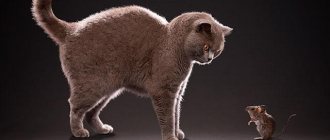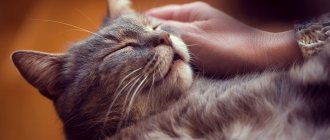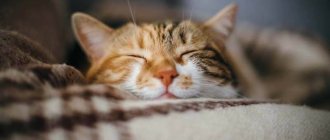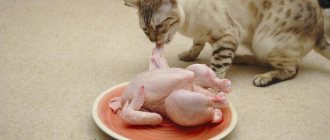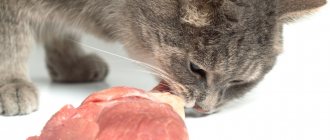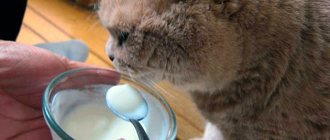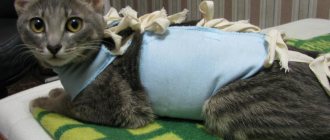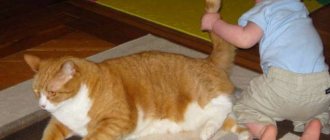We all know from childhood that the cat is the main enemy of the mouse. But in real life, not every mouse is ready to catch a mouse. Domesticated animals are often afraid of rodents and do not know what to do with them. And they have no desire to change their usual diet.
Each kitten acquires the skill of catching mice from its mother cat. If she taught him this vital activity, then in the future an adult animal will be able to catch rodents for food without any problems. But such a skill can only be imparted by homeless or village cats who themselves go hunting every day.
Cats have long helped humans in the fight against mice and rats, for which they were held in high esteem in Ancient Egypt and Rus'. It is believed that the ancestors of this animal themselves came to humans, after which they were domesticated, but to this day they have retained their independence.
A well-fed city cat is not inclined to catch, but the hunting instinct lives inside it. Therefore, under favorable circumstances, it may well become a “thunderstorm of mice.” Just before you start learning, there are a few things to consider.
Yard VS Thoroughbred
The hunting instinct is alive in every cat, regardless of the presence or absence of breed.
But in order to have the honor of being called the best hunter, the degree of expression of this instinct is important. In most cases, a purebred cat catches a mouse simply out of curiosity. She doesn’t try to eat her and doesn’t even always kill her: over the years of selection, breeders have managed to euthanize the cats’ natural inclinations, making these animals more suitable for life in a city apartment. So which cats are better at catching mice? It turns out that they are outbred? However, this is not always the case. Many owners deliberately breed completely domestic mongrel cats, but these cats also live in urban conditions, in apartments, and they see mice no more often than their blue-blooded brothers. If suddenly such a cat catches a rat, it plays with it for a long time, drags it back and forth, without trying to kill it with a precise bite to the back of the head, as real hunters do. And all because, in addition to a pronounced instinct, a cat requires skill. But how to teach a cat to catch mice?
This experiment was carried out back in the 1960s. Four cats and their offspring took part in it. The two cats were pedigree, and the cats for mating were selected accordingly. The other two are skilled hunters living on farms, mated with the same cats. Scientists made a substitution: outbred kittens were placed in purebred cats, and purebred babies were placed in farm cats. When the litters were not even three weeks old, the outbred cat caught a mouse and brought it to “her” kittens. The second yard dog did the same
The hunters taught the purebred kittens to handle their prey with caution and surgical precision. Outbred kittens raised by purebred “mothers” learned only to play, but not to kill - they were not given such an opportunity
As a result, it became obvious which cats are better at catching mice: those that were born and raised in certain conditions, with access to natural prey, raised by rat catchers and with small claws knowing why, in the opinion of hunting cats, nature created mice and other small animals. living creatures
This experience proved that, despite the importance of heredity, upbringing and the conditions for raising litter play a decisive role in the issue of catching rodents.
Therefore, when choosing a future thunderstorm of mice, you should rely on the conditions of keeping the kittens. Ask your neighbors about this question: there is almost certainly a cat living on one of the adjacent plots, whose owners annually adopt kittens born from the gulena
You can bring a rat catcher into a private home directly from the street - a kitten born in the basement already has the necessary skills at the age of three to five months. What breeds of cats catch mice? These are animals of natural proportions, raised in a nursery in a suburban area (with access to the street, and not living in enclosures). These include our Siberians, Russian Blues, Thais, Kuril Bobtails and overseas beauties - Maine Coons, Abyssinians, Bengals, Ocicats, European Shorthairs.
Catching mice, ways to train a cat
Despite the fact that all cats should catch mice, because it is inherent in them at the genetic level, there are those who do not want to do this, do not like and are even afraid of mice. To train a cat to catch mice, you need to do certain things.
In order for you to succeed, you need to take any toys, especially those that the cat likes most, and tie them to a fishing rod or similar device. Be sure to take treats with which you will reward your pet for a job well done. All these activities will be carried out so that your cat learns to catch mice, listens to its instincts, and, in addition, receives daily physical activity, which is important for any animal, especially a domestic one.
Now we will take a closer look at how to teach a cat to catch mice:
- The first thing to do is to find a toy in the shape of a mouse so that the cat’s external image of it is fixed. In order for the animal to more actively come into contact with the toy, it needs to be slightly moistened with catnip, which attracts cats. It is this kind of device that will allow the pet to learn to play with such an object. Under natural conditions, a mother cat teaches her kittens how to hunt in a completely different way: she immediately brings them a completely dead mouse, then one that is still alive, but seriously injured, and then teaches them to hunt and crush mice by example. A kitten who has been able to find, catch and kill a mouse at least once will never forget this skill. If the cat is domestic and grew up without parents, there is no place for him to take an example, so a person must help him. The learning algorithm will be exactly the same as for mother cats, so you will need to find live mice and introduce your cat to them in the same order. Preliminary games with a toy mouse will be the first step to raising a hunter.
- When the cat is interested in the toy, you must definitely pay attention to this, praise it well and treat it with a treat.
- After this stage, the toy must be tied to a fishing rod or similar device. The toy remains on the floor and is pulled along the floor using a fishing rod. The cat needs to be called so that it pays attention to what is happening around it.
- When moving a toy across the floor, it is important to make abrupt and unexpected movements so that the cat becomes interested in this object and pays all its attention to it. A toy that also smells like catnip will arouse genuine interest in your pet. It is very important to note any actions of the cat, praise him and treat him with tasty treats.
- Once you have taught your cat to handle a toy mouse inside the house, it is important to change the environment and go outside into a more natural environment for the animal. The game does not change in its essence, the toy still drags along the ground, but now the grass and various buildings interfere with the cat, making it much more difficult to navigate and catch the object. The pace at which you need to drag the mouse should be such that the cat has time to react, but the task is feasible for him. It is important to let the pet get to the prey and catch it in its paws, in order to feel within itself that very hunter whom the owner seeks to awaken. As soon as the cat reaches the mouse and grabs it, it is important to pull the rope to simulate the mouse’s attempts to escape from the cat’s clutches. Such games will help the cat adapt to the behavior of its future prey, and it will be ready for it. At this stage, the pet is also treated to something tasty for the successful actions taken.
- With each training session, it is important to reduce the time when the mouse is motionless, so that the cat learns to react and attack the target faster. As soon as the prey is caught, you must praise the cat. As soon as such games become familiar, normal and easy for the cat, you should introduce him to real mice, using the example of the cat’s mother, and only after that let him go fishing. At first, it is important to support the cat, praise him for victories and caught mice, and reassure him if the hunt is unsuccessful. After several successful exits, your cat will definitely be able to become a real predator in terms of chasing mice, and the goal will be achieved.
From the above exercises it follows that almost any cat can be taught to hunt mice if you have the desire and opportunity. If a cat lives in a private house and constantly deals with other cats, he will learn to hunt himself, simply by what he sees every day. If your cat has given birth to kittens, she will train them herself and easily teach them how to get tasty little mice for dinner. If you do not have such conditions, and the cat lives in an enclosed space, but you still want him to have the instincts of a hunter and be able to catch a mouse if necessary, then you need to take care of his upbringing personally. There may be several methods and variations, the main thing is to understand the main thing, the cat must understand what a mouse looks like and how it can move and behave. To interest him, the training object must be soaked in catnip. It is best to choose a toy that is as similar as possible to a real mouse to visualize the cat's prey. This period will not cause much difficulty for both you and the cat, but if you decide to continue and introduce your pet to real mice, then this part of the training will not be pleasant, because having a dead mouse in your house , in itself is unpleasant. However, after suffering only a few times, you will achieve the awakening of hunting instincts from your pet, and as soon as he sees the target, he will overtake it and deal with it, of which you can be absolutely sure.
Other breeds
As a hunter for a private home, you can purchase the following breed of cats:
European Shorthair
Smart, active and inquisitive pets, distinguished by courage and bravery. The European Shorthair cat adapts to any weather conditions and is distinguished by its affectionate behavior.
In the fight against rodents, animals have proven themselves to be ruthless killers. European tabby. The color of the animal is similar to that of a tiger. Tabbies are distinguished by their strong structure and muscularity, have a strong, large head, sharp teeth and claws. The hunting instinct is inherent from birth, so they grow up to be excellent mousecatchers. Turkish Angora. Cats of this breed have snow-white fur and blue eyes. Despite its defenseless appearance, the Turkish Angora tends to live in the yard and lead an active life. Thanks to fearlessness and curiosity, the pet effectively catches mice.
By what external signs can one identify a future mousetrap?
It is believed that a cat that can successfully catch mice must look the part. What signs can be used to determine which kitten will be an excellent rodent exterminator?
Signs of a mousecatcher:
- long mustache;
- wild color - black, red or gray, two or three colors, with faint stripes and spots to blend with nature and remain invisible to its prey;
- short hair – long and thick guard hair when wet acquires an unpleasant odor, which can scare away the rodent;
- large ears and triangular head;
- large paws.
They tried to choose the best rat catcher using these signs several decades ago. In reality, there are no perfect rat hunters. Every cat has a hunting instinct from birth, but not all representatives of the feline family realize it with equal success.
Before you take a kitten into your home to catch mice, you should ask whether its mother was a good hunter. When raising their cubs, cats pass on their skills to them, including in catching rodents.
If the pet was taken from the street, it is highly likely that its hunting skills will be well developed. In purebred pets, the instinct is dulled, especially if several generations of animals have lived in apartments and do not even know what a mouse or rat looks like.
Is it possible to teach a cat to hunt if she doesn't show much desire to catch mice? In order for the animal’s natural instincts to awaken, it is necessary to let the pet feel a slight feeling of hunger. A cat should not be completely deprived of food - this is cruel and fraught with health problems. You just need to reduce the portion size: malnutrition will awaken the instinct in your pet. After the first successful hunt, it is advisable to reward the animal.
You need to teach your pet to hunt from childhood. There is no point in training an adult castrated cat. The purpose of its existence is food and sleep, such animals become lazy and quickly gain excess weight, and it becomes more and more difficult for them to run every year. But you can and should awaken a kitten’s interest in hunting. To do this, catch the mouse using a mousetrap and let your child play with it while it is still alive.
To activate the kitten's hunting instinct, you should play with it more often using a laser pointer or special toys. If your pet tirelessly chases them, he will become a professional in catching mice.
Can a domestic cat catch rats?
Sometimes people wonder: how good are cats at catching rats? Are they all capable of this? Some people are interested simply out of curiosity, others are thinking about getting a rat-catcher cat. The Murkoshi team is ready to give answers to these questions, talking about how and under what conditions a cat can become a rat hunter, and whether it is really necessary to send your pet to this dangerous activity.
1) Cats, rats and people: a history of relationships
2) The importance of hunting in the life of cats
3) How a mother cat teaches kittens to hunt
4) So how good are modern house cats at hunting rats?
5) What should a good rat catcher be like?
6) Is rat hunting safe?
7) What can replace hunting?
Cats, rats and people: a history of relationships
Of all rodents, rats cause the greatest harm to people. They eat and destroy crops and food supplies in warehouses and barns, gnaw things, and most importantly, they can spread infectious diseases through bites. Thus, in the United States, about 14 thousand people suffer from rat bites every year. In Moscow in 2016, 102 people were bitten by rodents.
And this is now, when a person has various means of deratization in his arsenal. What can we say about the dawn of civilization, thousands of years ago, when humanity had just switched to agriculture, it began to store grain reserves in barns, and rats flocked to them, threatening to doom entire settlements to starvation. Who knows, perhaps no civilization would have arisen if cats had not followed the rodents and literally saved man. Therefore, it is not surprising that in warm countries (primarily in the Middle East, where civilization arose), where the issue of pests is especially acute (and the fight against snakes, which cats also hunted, is also relevant), at all times there has been a special attitude towards cats, somewhere even sacred.
But in medieval Europe, cats were underestimated, they were considered accomplices of witches and the devil and sources of all kinds of misfortune. Alas, furry purrs were often destroyed. For this, the Europeans paid a high price - rats bred en masse on the continent, which brought the plague with them. Epidemics took up to a third of the population with them.
Read more about the history of cat domestication: https://www.murkosha.ru/nashi-stati/interesnoe-o-koshkakh/koshka-kotoraya-do-sikh-por-gulyaet-sama-po-sebe-istoriya-odomashnivaniya-koshek
The importance of hunting in the life of cats
Over the centuries and millennia, people have changed a lot. Cats, albeit to a lesser extent, have changed too. Nowadays there is no need for pets to hunt; the most useful qualities for survival turned out to be those that are pleasant to humans - contact, affection, and complaisance. But hunting instincts still lie dormant in every pet.
Cats are predators by nature, and hunting is firmly ingrained in their genes. Therefore, you should not be surprised when you see a cat hunting a mouse, a bird, a frog, or a rustling candy wrapper.
Some cats are still excellent hunters, in no way inferior to their wild ancestors. All kittens are taught basic hunting skills by their mother cat.
How a mother cat teaches her kittens to hunt
About five weeks after birth, the mother cat begins teaching her kittens how to hunt. Before this, the kids play among themselves, “fight.” For them, the game, first of all, is preparation for the hunt.
Initially, the mother cat catches the mouse, kills it, brings it to the kittens and eats it before their eyes. Then she brings mice to the kittens, giving them the opportunity to eat themselves. And finally, when the kittens reach the age of 2.5 - 3 months, the cat brings the mouse while still alive, allowing the kittens to kill it themselves.
Usually the cat watches from the side as they cope with the task. If the prey manages to escape, the mother cat catches it again and returns it to the kittens, giving them another try. Kittens have a well-developed attack instinct, but it is often not justified. If the mother sees that the kittens’ actions are ineffective, then she shows by her own example how to do it.
The interest in killing a mouse on your own for the first time is stimulated, first of all, by the atmosphere of cheerful competition that reigns among kittens of the same litter.
Of course, there is no talk of any rat hunting at this age. The mother cat simply will not let the kittens near the rat (as well as the rat near the kittens), unless she brings a little rat. Still, an adult rat can be dangerous even for a small and/or pampered cat, let alone a kitten. For comparison: if a mouse weighs on average 30 g, then an adult rat weighs on average 330 g, and some individuals are much larger.
Although the cat still helps to hone hunting techniques, including large rodents. So at 8-12 months the kitten can try its hand against a rat.
So how good are modern house cats at hunting rats?
There is no clear answer to this question. Many “hereditary” domestic cats (born in apartments, raised by a mother who was also a domestic cat all her life, etc.) may never even see a living mouse, and not in the first generation. Naturally, the hunting skill becomes dull. A running rodent will still attract the cat's attention, but it is unlikely that an untrained pet will seriously get involved with a rat.
An adult, seasoned rat, unlike a mouse, is able to fend for itself. When faced with a cat, an experienced rat stands up on its hind legs (so it appears larger) and... begins to chase the cat. It’s not for nothing that they say that the best defense is an attack. An inexperienced domestic cat, not expecting such behavior from the victim, gets lost and runs away. Only a pet with a very lively nature can not be afraid of such a daring counterattack. In this case, the rat gets lost and runs away. But even in this case, an inexperienced hunter can, at best, injure the rat, but in the end it will still run away.
To catch such a dangerous rodent, you need skills, physical abilities and motivation. An insufficiently motivated cat will most likely choose not to get involved.
What should a good rat catcher be like?
The rat-catcher cat must have a strong, stocky body, and must have powerful jaws (they will be needed for gripping and a strong bite, which will immobilize the victim). A long mustache is also required. It’s not for nothing that a kitten used to be chosen based on its rich whiskers - it’s both beautiful and, most importantly, useful. After all, with the help of its whiskers, a cat detects the slightest vibrations in the air, estimates the distance to the target and orients itself in the dark. Extremely fine hearing is also very important.
The rat-catcher cat must quickly notice the prey, rush sharply, simultaneously strike with both paws and immediately grab the scruff of the neck with its teeth. Only in this case the adult rat does not stand a chance.
By the way, as statistics show, in 9 cases out of 10 it is cats who catch rats, not cats. There is an opinion that this is due to the protection of offspring, because rats are very dangerous for a small kitten.
Here the answer, alas, is clear - no, it is not safe. In this case, the cat faces two dangers at once. The first is due to the fact that this pest can fight back and injure it, infecting it with various viruses, including those that are 100% likely to lead to death (such as rabies). Rats are the main carriers of rabies, so it is deadly dangerous for an unvaccinated cat to hunt them. In any case, your pet needs to be vaccinated on time, even if he does not leave the house - to eliminate the slightest possibility.
Read more about the importance of vaccinations: https://www.murkosha.ru/nashi-stati/lechenie-i-profilaktika/privivki-u-koshek-chto-kak-zachem
The second danger is that rats, especially in the city, are often poisoned. If the cat does catch a rat and eats it, it may be poisoned. Therefore, “Murkosha” categorically objects to self-walking of cats - on the street, in addition to this danger, there are many other dangers for pets.
Read more about the dangers of self-walking: What is cat self-walking and why is it dangerous?
Moreover, this is also true for dachas and rural areas. You can walk your cat only in the local area and only on a harness under the supervision of the owner. Cats do not need to go out on their own and hunt, especially dangerous prey like rats. As for protecting the house from these pests, the very presence of a cat in the apartment will provide it. Yes, a cat can be afraid of a rat, but rats are much more afraid of cats. Rodents prefer to avoid places where there are cats.
You may ask: what about hunting? After all, we started the article with the fact that it is incredibly important for cats. Now we recommend depriving her of pets. Won't this affect their well-being, activity and, ultimately, their health?
Not if hunting is replaced by play. For a cat, play is hunting, and a toy is prey. The kitten, playing with its mother cat and other kittens, learns to hunt in the process. So it is not surprising that play can replace hunting for adult cats. Therefore, if you play with a cat at least 2-3 times a day for 10-15 minutes (with a kitten, of course, you need to do it more often), this will provide him with the necessary level of activity.
Read more about playing with a cat: Why do cats play and how to do it correctly with them?
You can easily verify this by visiting the Murkosha shelter. Even when in a confined space, cats strive to play, often trying to attract guests to this. Games with employees, volunteers and guests help them live a rich and interesting life, and remain cheerful and active even in their advanced years.
Character and behavior of lop-eared animals
The Scotsman is a purebred cat that is distinguished by its kind disposition. Distinctive behavioral traits:
- communication skills and sociability;
- love for children;
- gaiety;
- easy to educate with the right and friendly approach;
- actually cannot be trained;
- playful;
- not mischievous;
- they quickly forget bad things and do not take revenge.
Scottish Folds are an ideal option when there are other animals and children in the house. Such kittens are real aristocrats with their mannerisms and waywardness. Their restiveness and capriciousness are often observed. If the Scots want something, they will definitely achieve it. An adventurous breed with a curiosity for the unknown. When new people appear on their territory, Scottish cats are not very friendly, but then they begin to communicate. Scots love to play, but are not particularly happy with cuddling and cuddling.
How to teach a cat to catch mice
In order for a cat to catch a mouse, it is necessary to initially raise the kitten correctly. At birth they do not have the necessary skill. The mother cat does the upbringing. To develop a hunting character in your pet, you need to train it from an early age.
Some people mistakenly believe that if you don't feed the rat catcher cat before hunting, the cats will catch rats faster and in greater numbers. In fact, the pet needs food to generate energy for hunting.
A hungry cat will have a more difficult time completing the task. If you want a happy cat with a mouse in its teeth to not be a rare occurrence for you, then you shouldn’t starve it.
How to make a cat catch mice: do not overfeed the rat catcher's cat, do not make the rat catcher's cat starve. In addition, you need to reward your pet if it catches a mouse or rat.
Play with your cat using live bait. Catch rodents in mousetraps and give them to your cat. Do not use poison for catching, you can harm the health of your pet.
What to do if the cat does not catch mice:
- Understand the reason for this behavior. Perhaps your pet is sick with something. Visit your veterinarian.
- Feed properly in small portions 5-6 times a day.
- Perhaps sterilized animals have an incorrect diet, create a dietary menu.
It is quite difficult to train a kitten to catch mice, so the mother takes responsibility for raising the kitten. At what age do kittens begin to catch mice? The ideal period for this is 4-5 months.
Keep in mind that your pet needs to be vaccinated before engaging in rodent control. The main one is the rabies vaccination. If your pet is bitten by a rat, immediately take it to the veterinarian for an examination.
At what age does a kitten begin to catch mice on its own?
Let’s not keep the intrigue going and answer right away: a kitten becomes a hunter at three months.
Now let’s tell you in a little more detail how, who and when teaches kittens to hunt.
We got our own cats not only for the sake of their beauty and cuteness. We were plagued by mice, gnawing everything they could in the house and garden. With the advent of cats, the problem was solved.
Now we have two cats and a male cat living with us. They grew from kittens into adult hunters before our eyes, and this always happened in three stages and according to the same pattern:
1.
When the kittens are
a month
, the cat catches and brings into the house the first mouse for her babies. The kittens are still too tiny to play with her, so the first acquaintance comes down to sniffing, and sometimes they can timidly touch her with their paw.
2.
At
two months,
the mother cat brings another mouse, and already then the grown kittens begin to excitedly chase after it, play and take prey from each other.
3.
When the kitten turns
three months
, he brings his first independent hunting trophy into the house.
Today, kitten Kazimir caught his first cockchafer-sized mouse in the garden and proudly laid it at our feet during breakfast.
Then he tormented his prey for a long time and recklessly. A worthy heir to Mitrich, the founder of our cat pride, is growing up.
By the way, we noticed that as cats age, they become less inclined to hunt mice. The best hunters are teenagers under one year old. In the photo below you can see how the five-month-old Turtle (Kazimir’s mother) is chasing a mouse around the kitchen, and her parents - red-haired Mitrich and Marusya - lazily watch her, without interfering in the game.
Source
Who is the best hunter - a cat or a cat?
Who is better at catching rodents - a male or a female? It is believed that the best rat hunters come from stray cats. Maternal instinct forces the female to hunt, and the cat hones her skills to perfection.
Males are not as active as cats. Their main task is procreation; for this, the cat needs to interest and attract the female. However, a cat deprived of food, forced to rely only on itself to solve the “food issue,” is guided by instinct and becomes an excellent hunter.
Cats hunt mice and rats most actively about once a quarter, before the approach of estrus. Consequently, about 3-4 times a year, a pet can clear a house or apartment of uninvited guests. The best candidate for the position of mouser is considered to be a cat.
Recommendations
A hunting cat spends a lot of time outdoors, in contact with other animals, which increases the likelihood of infection and the development of diseases. To protect your pet from diseases, you need to remember the following rules:
- the cat must be periodically vaccinated against potential diseases;
- the pet needs to be fully fed and fortified with vitamin supplements, which will strengthen the immune system;
- every 5 months, clean your pet of worms for the purpose of prevention;
- the animal needs to buy a flea collar that prevents the spread of parasites;
- in early spring, before a walk, it is recommended to treat your pet’s fur with protective sprays, since in May the likelihood of insect attacks increases.
For preventative purposes, you can take your cat to the veterinarian for examination once every six months.
How does castration affect the hunting instinct?
Owners of apartments in urban high-rise buildings are not particularly concerned about the loss of hunting skills in their cat after sterilization. But for owners of private houses this topic is extremely relevant. How does the castration or sterilization procedure affect an animal’s ability to kill rodents?
The decision to neuter a cat will not greatly affect its hunting instincts. Cats before and after castration exterminate rats and mice in the territory entrusted to them with equal eagerness and skill. The exception is castrati who are overweight, which appears due to a sedentary lifestyle and too high-calorie diet. It is difficult for such pets to move, and their hunting skills are gradually reduced to zero.
Since the ability to hunt in cats is inherent at the level of instinct, it is difficult to influence it by sterilization. After the procedure, the animal may become less active and mobile, go out hunting less often, but this will not make the ability to track and catch a mouse disappear.
While cats often become fat and lazy after castration, spayed females, on the contrary, show more interest in hunting. Many cat owners claim that after their pet has become infertile, it goes hunting more often and brings its owners the trophies it catches. In addition, having lost interest in the opposite sex and not spending time and energy on bearing and feeding offspring, the cat directs all its energy to satisfying the hunting instinct.
In general, a tendency towards hunting and active games can be identified in an animal even in childhood. If, as a kitten, the pet is not distinguished by curiosity, nimbleness and activity, it is unlikely that in adulthood, especially after castration, it will be drawn to adventures. Typically, castrated cats become more obedient, calm and balanced.
